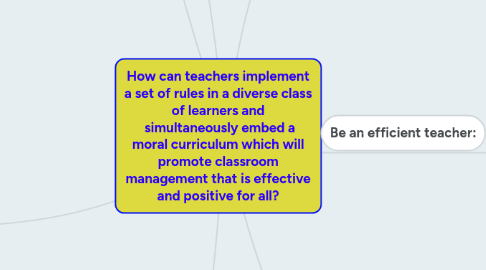
1. When students continually misbehave, teachers need to...
1.1. Understand the behavioural, cognitive, and emotional variables affecting that behaviour
1.2. Believe that we are important agents of change to these behaviours
1.3. Meet with parents and involve them in the process of improving their child's behaviours. Attempt to understand the entire picture of the child; cultural background, living situation, SES, gender, parental involvement.
2. Enforce rules, BUT continue to view the child wholistically and give individualized consequences
2.1. Avoid power struggles
2.1.1. Ex: Speak with the student privately, show them you care and you're listening
2.2. Provide logical consequences
2.2.1. Ex: Breaking the rule of 'no hitting'. Consequence is doing something nice for the victim before the end of the day
2.3. Social contracts
2.3.1. Ex: Allow ALL students to have a voice and agree upon unacceptable/acceptable behaviours before they occur
2.4. Be fair
2.4.1. Ex: Teach students that not everyone will always be treated the same and each student deserves individual consideration depending on the circumstance. Sometimes consequences are tailored to the individual to be fair.
2.5. Use rules that make sense and can be explained
2.5.1. Ex: The reason we don't use bad names towards others is because their feelings will get hurt.
2.6. Exclusion as a last resort
2.6.1. Give reasons for this exclusion and provide a discussion
2.7. Be Culturally Responsive
2.7.1. Guidelines and expectations are set and take into consideration the diverse cultures and needs in the classroom. They are able to meet the individual and collective needs of the student population.
2.8. Classroom management, not behaviour management
2.8.1. Rules are enforced based on ethics and morals embedded into teaching and classroom culture. The classroom is a community. Students are more likely to adopt the values most noticable in the room.
3. Contradictory beliefs:
3.1. Consequences for misbehaviour should be consistent
3.1.1. Yet they must also be fair and look to use preventative measures in the future.
3.2. Consequences for misbehaviour should be individualized
3.2.1. Yet appropriate for the situation, the individual and the community.
4. Interweave and teach a separate curriculum within a positive culture
4.1. Self-regulation and responsbility
4.1.1. Ex: Increase a student's autonomy with inquiry based learning, problem based learning or technology based learning.
4.1.2. Ask for student feedback on the classroom climate and teaching techniques used. Creating a safe, productive environment that values their opinions will ensure all needs are being met and aim to prevent future behavioural issues.
4.2. Character or Moral Education, whether indirectly or directly, should be taught as an equally important curriculum
4.2.1. Develops a sociomoral classroom environment
4.2.2. Observe and promote classroom virtues of courage, care, honesty, fairness and practical wisdom
4.2.3. How teachers manage their classrooms with moral virtues will determine how it permeates in the greater context of the school community
4.2.4. Ethic of Care: model care for students, enjoy dialogue with students, respect students, consider students on a wholistic level
4.2.4.1. Students begin to care for themselves, others, plants, animals, objects and the environment around them.
4.2.4.2. There isn`t a need to control students. Instead, classroom management is a process of moral instruction and encouragement and students come to understand the reasons behind rules and expectations.
5. Understand "Behaviour Management":
5.1. Need to understand the situation in context
5.2. A wholistic approach
5.3. Pick your battles
5.3.1. Respond strategically, not emotionally to the behaviours.
5.4. Emotional well-being = academic learning
5.5. A fine balance. Need to consider:
5.5.1. the exceptionality
5.5.1.1. home situation
5.5.1.1.1. level of socio-emotional development
5.6. There is a difference between behaviour vs. classroom management
6. Be an efficient teacher:
6.1. Foster relationships of respect and trust
6.1.1. Make the student feel valued
6.1.2. Create a learner centered environment. Maintain high levels in their self esteem
6.2. Program plan in advance to meet individual needs
6.2.1. Be organized. Your personal style matters- show you care. Differentiate. Be inclusive.
6.3. Appropriate rules and limits
6.4. Help students fell connected to the classroom
6.4.1. Learn what they're interested in, use it to create engaging curriculum
6.5. Possess a growth mindset and encourage one from his/her students
6.5.1. But also, hav an empathetic mindset and see the world through the child's eyes in order to to respond the most effectively to your students' needs
6.5.1.1. Leave your ego at the door!
6.6. Understand the developmental stage of one's students.
6.6.1. Your attitudes towards students affects their behaviour
6.6.2. Learn their strengths, weaknesses,
7. It's possible to enforce rules through consistent consequences for the individual student
7.1. Create classroom rules
7.1.1. Ex: Explain, practice and review rules. Inform students about consequences and monitor compliance. Enforce rule-violation consequences consistently.
7.2. Management activities at beginning of the year
7.2.1. Provide explicit, guided instruction for all.
7.3. Monitor student performance
7.3.1. Monitor entire classroom. Respond to individual misbehaviours promptly and consistently.
7.3.2. Respond to their efforts with visible and tangible positive praise. Ex: Attach specific feedback to their work of what you really liked about it and how they could improve.
